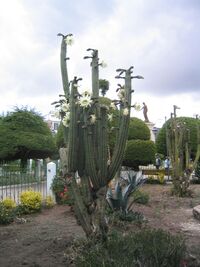Entheogen

Entheogens (from the Ancient Greek ἔνθεος entheos ["god", "divine"] and γενέσθαι genesthai ["generate" - "generating the divine within"]) are a family of psychoactive substances, typically of plant origin, that are used in religious, ritual, or spiritual contexts. Jonathan Ott is credited with coining the term in 1979.[2]
Entheogens have been used in a ritualized context for thousands of years and their religious significance is well established with anthropological and academic literature. Examples of traditional entheogens include psychedelics like peyote, psilocybin mushrooms, ayahuasca, and iboga; atypical hallucinogens like salvia and Amanita muscaria; quasi-psychedelics like cannabis; and deliriants like datura.
With the advent of organic chemistry, there now exist many synthetic drugs with similar psychoactive properties, many of which are derived from these plants. Many pure active compounds with psychoactive properties have been isolated from these respective organisms and synthesized chemically. These include the naturally occurring mescaline, psilocybin, DMT, salvinorin A, ibogaine, ergine, and muscimol, the semi-synthetic LSD, and synthetic substances (e.g., DPT used by the Temple of the True Inner Light and 2C-B used by the Sangoma).[3]
More broadly, the term entheogen is used to refer to any psychoactive substance used for its religious or spiritual effects, whether or not in a formal religious or traditional structure. This terminology is often chosen to contrast with the recreational use of the same substances. Studies such as the Marsh Chapel Experiment have documented reports of spiritual experiences from participants who were administered psychoactive substances in controlled trials.[4] Ongoing research is limited due to widespread drug prohibition; however, some countries have legislation that allows for traditional entheogen use.
Etymology
The term "entheogen" comes from the Greek en, meaning “in” or “within”; theo, meaning “god” or “divine”; and gen, meaning “creates” or “generates.” It translates as “generating or creating the divine within".[citation needed]
Entheogens in literature
Consumption of the imaginary mushroom anochi as the entheogen underlying the creation of Christianity is the premise of Philip K. Dick's last novel, "The Transmigration of Timothy Archer".
Aldous Huxley's final novel, Island (1962), depicted a fictional entheogenic mushroom — termed "moksha medicine" — used by the people of Pala in rites of passage, such as the transition to adulthood and at the end of life.
In his book "The Sacred Mushroom and the Cross: A Study of the Nature and Origins of Christianity within the Fertility Cults of the Ancient Near East", John M. Allegro argues etymologically that Christianity developed out of the use of a psychedelic mushroom, the true body of Christ, which was later forgotten by its adherents.
See also
- Responsible use
- Naturally occurring sources
- Psychonautics
- Hallucinogen
- Psychedelic
- Dissociative
- Deliriant
External links
- Entheogen (Wikipedia)
- Entheogenic drugs and the archaeological record (Wikipedia)
- Psychedelics and ecology (Wikipedia)
- Entheogens (Erowid Vaults)
References
- ↑ A Brief History of the San Pedro Cactus
- ↑ Wasson, R. G., Hofmann, A., Ruck, C. A. P. (2008). The road to Eleusis: unveiling the secret of the mysteries (30th anniversary ed ed.). North Atlantic Books. ISBN 9781556437526.
- ↑ 2CB chosen over traditional entheogens by South African healers., 2013
- ↑ Griffiths, R. R., Richards, W. A., McCann, U., Jesse, R. (August 2006). "Psilocybin can occasion mystical-type experiences having substantial and sustained personal meaning and spiritual significance". Psychopharmacology. 187 (3): 268–283. doi:10.1007/s00213-006-0457-5. ISSN 0033-3158.